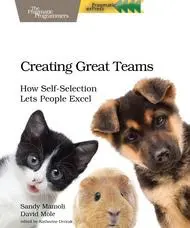Arlen’s Appreciative Book Inquiries explores Creating Great Teams: How Self-Selection Lets People Excel by Sandy Mamoli and David Mole

How do you rapidly spin up new projects? How do you keep teams engaged and excited about their work? How can you attract better talent? How should teams be designed?
I’ve received each of these questions dozens of times over the years, and more so lately as organizations look for patterns for designing the best teams possible. One approach that has some promise in addressing these issues is one that several of our clients have tried to very good effect, and which might be considered rather radical; tell people what’s important to the organization today, and let them form the teams themselves!
Some great ideas for dealing with the questions above are found in Creating Great Teams: How Self-Selection Lets People Excel by Sandy Mamoli and David Mole, a pithy little book that gets right to it. In 79 pages it covers why stable teams are beneficial, how to prepare for and run a self-selection event that allows people to form teams around pre-set goals over a series of rounds, and what to do in the long term after teams are formed. Sandy and David hail from New Zealand, where they helped drive agility at Trade Me, a site that generates half of New Zealand’s domestic Internet traffic.
The issues they’re targeting:
- No continuity to teams limits their growth in project settings
- Dependencies are exacerbated by targeted allocation of individuals to known systems
- Waiting is caused while waiting for staff to come available from projects
- Handovers of products after projects limits ownership and causes knowledge loss
- People “take more responsibility for their own decisions than those made by others.” Esther Derby
They make the case that self-selection isn’t a new or radical idea, having been tried to great success in forming the Royal Air Force’s Lancaster bomber crews during World War II, and later at Atlassian for their 24-hour ShipIt Day hackathons, which were a direct inspiration and starting point for the eventual dive headlong into full long-term team self-selection at Trade Me.
They suggest a six-step process to prepare for the self-selection process that comprises the majority of the effort (the event itself lasts only a single day):
- Conduct a Readiness Check
- Run a Trial
- Get Permission
- Define the Teams to Select
- Coordinate Logistics
- Communicate Early and Often
The event is simple, led by a “Squad Master” (e.g. ScrumMaster) and Product Owners for each team to be formed. The missions for each team should be reasonably well understood, as POs will essentially pitch their respective visions in order to attract team members. The basic process is as follows:
- Introductions and rules
- Product Owners pitch their team’s visions
- Team members spend ten minutes attaching to a team (noted via a photo)
- Repeat 3-4 times until problems are resolved
Once teams are formed, they suggest that you re-run a self-selection bazaar roughly every six months. It was interesting that in their case team members largely stayed together for more like two years before moving on though.
This book is deeply practical. These are step-by-step instructions suitable for jumping right into facilitating a self-selection event yourself, and the authors spend considerable energy addressing the many objections sure to be raised in a simple FAQ style. We at LitheSpeed have had some experience with self-selection at a few of our clients, and this book was their main reference in preparing for the events, which consistently went well, so that says something too.
Creating Great Teams takes a seemingly radical subject and brings it right down to earth, introducing things in a manner that makes running a self-selection event yourself seem accessible. I believe the approach makes a lot of sense if you’re able to generate the support, and this book would be a great place to start plotting your grand self-selection scheme.
As Esther Derby eloquently states in the foreword, “This book will help many managers realize that the opposite of managerial team selection isn’t chaos. It’s commitment, creativity, and engagement, which is what they’ve been searching for all along.”
Arlen Bankston is one of LitheSpeed’s founders and lead instructional designer.
Get in touch with our experts for help creating great teams.

